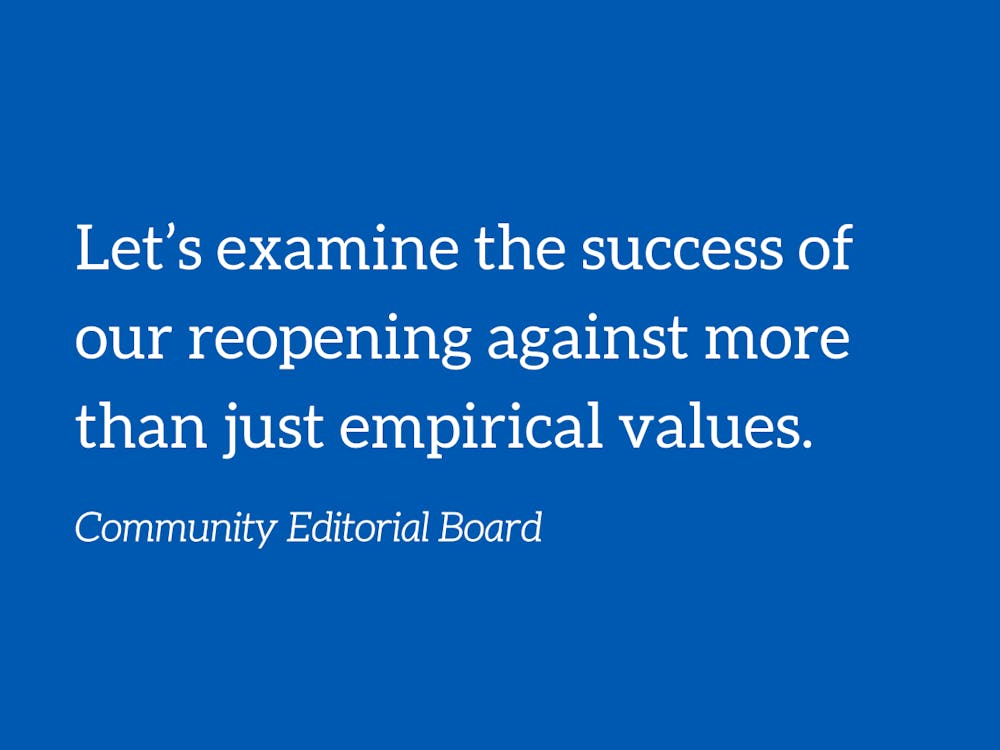After continued low positive COVID-19 cases, the Duke community feels very high and mighty—not that this is a new feeling for us. Out of UNC and NCSU, we’re the last vertex of the Research Triangle left with an in-person fall semester. To make this happen, our surveillance COVID-19 testing schedule has ramped up to 14,000 tests per week. Fall sports have resumed with no complications. By almost any metric, our this semester’s reopening has been successful thus far.
Duke, perhaps overconfident from any one of the accomplishments above, is looking ahead to welcoming back all undergraduates for the spring semester. Here there is an implicit acceptance of Fall 2020 as a win. However, let’s examine the success of our reopening against more than just empirical values.
A fundamental administrative goal for this semester was maintaining academic and institutional normalcy. The Keep Learning, Keep Teaching, and Keep Working campaigns are essentially a mantra that, if repeated enough, will materialize a world in which the only differences between the Fall of 2019 and the Fall of 2020 are masks and social distancing. The rolling video behind our homepage is a scene of an active campus, seemingly unbothered by a deadly pandemic. The idea of normalcy has captivated everyone’s attention, and it seems that Duke is not immune.
Since we pride (and advertise) ourselves on our sense of community, it is no surprise that togetherness was a key component of this artificial normalcy. DukeUnited, whose name alone stands as a plea for community, has the slogan, “Here. For each other.” However, the accountability system for the Duke compact, peer-policing, fundamentally disagrees with this. The contradiction between these two ideas of community is also meant to be reconciled by the student body itself as even Trinity College deans have a hard time following the compact.
It was easy to perceive our administration’s sole goal as a deliberately capitalistic one where reopening meant locking students into a nonrefundable housing contract, giving them a few weeks on campus and feigning ignorance once we were sent home. But who could blame the defeatists among us when many colleges have had this kind of procedural reopening? This pessimism has been partially put to rest by the Duke administration’s decision to keep upperclassmen off-campus, as it was a trade-off between the duration of our time on campus and approval from the student body, and they chose the objectively safer path. But, “objectively” ignores how students were left out in the cold with questions about how Duke’s updated plans impacted their tuition, financial aid and housing security.
Living on campus, an option not available to half of the undergraduate student body, is essentially an acceptance of the financial risk in getting sent home and inherently dependent on one’s ability to withstand the university’s lack of tuition relief or housing security. Our community—already marked by an obscene wealth gap—is further divided by the educational gap between in-person and remote learning. The entire student body being on campus had a way of equalizing, or at least patching up, this gap, but the disparities that higher education is supposed to overcome are further leaking into campus life.
At the beginning of the semester, on-campus life was overwhelmed with survival questions: How long are we going to last on campus? Is having a safer college experience even up to us? Is it worth it making long term plans in case we get sent home again? Now, the conversation from students and administration has shifted to a more confident tone, culminating in our new plans for spring. But while we are looking ahead to cherry blossoms and allergies, we are leaving behind a significant portion of our community who are still asking these kinds of questions. And here lies the problem with normalcy: The administration’s everything-is-fine stance invalidates and sweeps these experiences under the rug.
Here, we urge Duke to divest from normalcy and assume a larger role in salvaging our patented sense of community.
As appealing as Keep Learning and Keep Teaching are, the virtual Duke experience has not been a “rich one.” The administration’s current attitude on online teaching resorts to denialism, wishful thinking and a lack of creativity. Our first recommendation is to stop fitting the expectations of an in-person teaching model to online classes. Given a full semester, the transition to hybrid and remote learning would still be chaotic; so, our administration’s naive vision has no place in our condensed semester. Second, we propose splitting up breaks and distributing them throughout a semester. This is unlikely to follow in the coming weeks, but it is imperative for the Spring. A few days of Fall Break sprinkled into this semester would not have served the same purportedly selfish purposes, such as vacation or family time, as it usually would; here, these little breaks would relieve pressure and lessen burnout for both students and professors. The combination of these is the most direct way to reach out to our remote-learning community and recognize their efforts.
We also recommend that Duke relieve the pressure from on-campus students by diverting responsibility for Compact enforcement to faculty and staff. This is not to say that undergraduates should abandon all sense of interpersonal morality, but that distrust and suspicion should not govern the first-year experience.
Our objective success in reopening should not undercut the fragility of our community right now. This discordance might not make national headlines or factor into U.S. News and World Report rankings, but it deserves the full and utmost attention from our administration. No one else is holding us to this standard, so let’s call restoring our sense of community the upholding of the Duke Difference.
The Community Editorial Board is independent from the editorial staff of the Chronicle. Their column usually runs on alternate Mondays.
Get The Chronicle straight to your inbox
Signup for our weekly newsletter. Cancel at any time.

